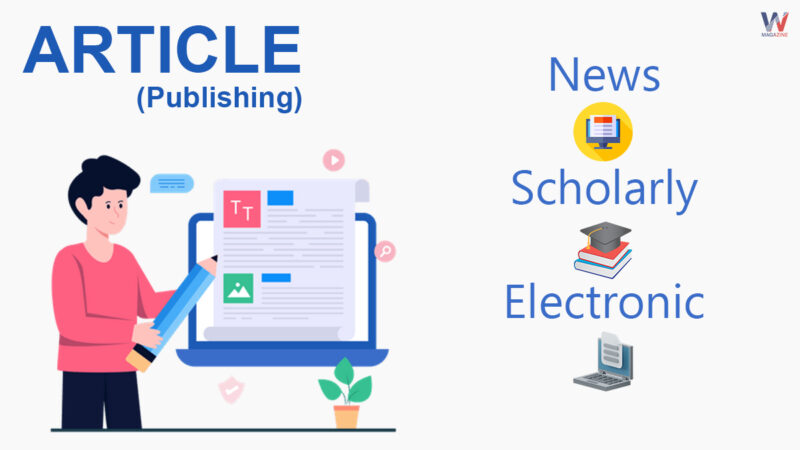Table of Contents
Definition
An article is a written piece published in print or online media. Its purpose is to share news, research findings, academic analyses or provoke debate.
News

A news article talks about current events or recent happenings that are either of general interest (like what you find in daily newspapers) or about a specific topic (like in political or trade news magazines, club newsletters or technology news websites).
News articles can include things like eyewitness accounts, photographs, statistics, graphs, interviews, polls and debates. They use headlines to highlight the main points. Writers also provide detailed information and answer questions like who, what, when, where, why and how.
Quoted references can be useful in articles. They can include people’s accounts from interviews and debates which help confirm the writer’s information and the reliability of their sources. You can go through Wordle Magazine’s LinkedIn article, hence it’s not a news article but the references have been quoted.
Writers can also use techniques like redirection to keep readers engaged. For example phrases like “Continued on page 7th” direct readers to another page where the article continues.
When writing for newspapers, it’s important to craft a strong conclusion. However, due to tight deadlines, sometimes editors must cut parts of the article to fit the available space. This is why reporters are trained to use the inverted pyramid style, putting the most important information first. By doing this, if some details are cut, the impact on the story is minimized.
Types of news articles include:
- Breaking news: Quick updates on events happening right now.
- News reports: Articles about local or world events like plans for a new school or a natural disaster.
- Feature stories: Longer, creatively written articles that include human-interest stories and news features.
- Investigative & enterprise reports: Articles where journalists investigate a subject not widely known.
- Lead-alls: Central articles that give an overview of major news events connecting to related articles.
- Columns: Recurring items.
- Opinion pieces: Editorials (written by the publication’s editors) and op-eds (written by people outside the news organization).
Scholarly

In academic publishing, a paper is a piece of academic work published in an academic journal. It presents original research or reviews existing research. For a paper to be accepted it must undergo peer review by academics in the same field who ensure its content is suitable for publication. The paper may go through several rounds of review and revisions before being accepted or rejected, a process that can take several months. After acceptance, there is often a delay before the paper is published especially in popular journals where the number of accepted articles exceeds the space available for printing. To address this, many academics make a preprint or postprint version of their paper available for free download from their website.
Electronic
Electronic articles are articles from scholarly journals or magazines that can be accessed online. They are a specialized form of electronic document with specific content, purpose, format and availability. These articles are meant for academic research and study and they are formatted similar to printed journal articles. Their metadata (information about the article) is stored in specialized databases like the Directory of Open Access Journals. Electronic articles are mainly available through academic and special libraries often for a fee.
Electronic articles can be found in journals that exist only online but they have also become common as online versions of articles that are published in print journals. Sometimes, an electronic version of an article is published online before it appears in print. This practice is called “epub ahead of print,” “ahead of print” (AOP), “article in press” or “article-in-press” (AIP) or “advanced online publication” (AOP) depending on the context.
The Version of Record (VoR) is the final and definitive form of an article. In electronic publications, the VoR is usually stable but some changes can be made.
The most important changes are correcting errors which are typically done within the electronic VoR itself. This ensures that readers are not confused or misled. The VoR may also reference an erratum or corrigendum (a notice of correction) for clarity.
Another type of change is updating the author’s name if they have legally changed it since the VoR was published. This update depends on the policy of each publisher.
The term “electronic articles” can also refer to electronic versions of less formal publications. These include online archives, university working paper archives, government agency reports and articles from private and public think tanks and institutes as well as private websites.
Specialized bibliographic databases are available in many academic areas to help find this online content.
Most commercial sites require a subscription or sell access on a pay-per-view basis. However, many universities subscribe to electronic journals to provide access to their students, faculty and sometimes others.
An increasing number of journals are now open access meaning they require no subscription. Most working paper archives, articles on personal homepages, collections in institutional repositories and subject repositories are free.
The most common formats for electronic articles are HTML (for web pages), PDF and, in specialized fields like mathematics and physics, TeX and PostScript.
Thinking of something different? Do you want to publish your article? Follow our contact page for further steps.









